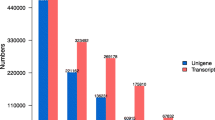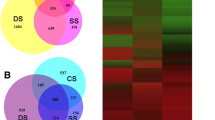Abstract
Formosan lily (Lilium formosanum), a species endemic in Taiwan, is characterized by showy and fragrant flowers. To understand the gene expression at its reproductive phase, we constructed a suppression subtractive cDNA library of immature flower buds, from which 1,324 expressed sequence tags (ESTs) were randomly selected and sequenced. These EST sequences were clustered into 974 nonredundant sequences. Based on BLAST searching, functions of 376 sequences (39%) were determined, and 80 sequences showed high similarities to genes encoding hypothetical proteins without known functions. Another 518 sequences did not show significant homology to any known sequences and were therefore classified as novel sequences. Further analyses of the 376 ESTs sequences revealed high abundance of stress-related and flower-development genes. The highly expressing stress-related transcripts include 39 with high similarities to lipid transfer proteins, five to ascorbate peroxidases, and five to heat shock proteins 70. Using real-time quantitative RT-PCR analysis, we further revealed the expression of these three genes in the immature flower buds and in the pistils or stamens of the blooming flower of Formosan lily collected from alpine regions. These results suggest that the flower of L. formosanum possesses a significantly elevated level of stress genes in response to alpine environment and the ESTs analyzed here represent a valuable resource for studying a resistance mechanism of the reproductive organs of Formosan lily.





Similar content being viewed by others
References
Altschul SF, Madden TL, Schaffer AA, Zhang J, Zhang Z, Miller W, Lipman DJ (1997) Gapped BLAST and PSI-BLAST: a new generation of protein database search programs. Nucleic Acids Res 25:3389–3402
Chang S, Puryear J, Cairney J (1993) A simple and efficient method for isolating RNA from pine trees. Plant Mol Biol Reporter 11:113–116
Coen ES, Meyerowitz EM (1991) The war of the whorls: genetic interactions controlling flower development. Nature 353:31–37
Davletova S, Rizhsky L, Liang H, Shengqiang Z, Oliver DJ, Coutu J, Shulaev V, Schlauch K, Mittler R (2005) Cytosolic ascorbate peroxidase 1 is a central component of the reactive oxygen gene network of Arabidopsis. Plant Cell 17:268–281
Douliez JP, Jégou S, Pato C, Larré C, Mollé D, Marion D (2000) Structure, biological and technological functions of lipid transfer proteins and indolines, the major lipid binding proteins from cereal kernels. J Cereal Sci 32:1–20
Endo M, Hakozaki H, Kokubun T, Masuko H, Takahata Y, Tsuchiya T, Higashitani A, Tabata S, Watanabe M (2002) Generation of 919 expressed sequence tags from immature flower buds and gene expression analysis using expressed sequence tags in the model plant Lotus japonicas. Genes Genet Syst 77:277–282
Endo M, Kokubun T, Takahata Y, Higashitani A, Tabata S, Watanabe M (2000) Analysis of expressed sequence tags of flower buds in Lotus japonicas. DNA Res 7:213–216
Falquet L, Pagni M, Bucher P, Hulo N, Sigrist CJA, Hofmann K, Bairoch A (2002) The PROSITE database, its status in 2002. Nucleic Acids Res 30:235–238
Felsenstein J (1985) Confidence limits on phylogenies: an approach using the bootstrap. Evolution 39:783–791
Garcia-Garrido JM, Menossi M, Puigdomenech P, Martinez-Izquierdo JA, Delseny M (1998) Characterization of a gene encoding an abscisic acid-inducible type-2 lipid transfer protein from rice. FEBS Lett 428:193–199
Gaudet DA, Laroche A, Frick M, Huel R, Puchalski B (2003) Cold-induced expression of plant defensin and lipid transfer protein transcripts in winter wheat. Physiol Plant 117:195–205
Guterman I, Shalit M, Menda N, Piestun D, Dafny-Yelin M, Shalev G, Bar E, Davydov O, Ovadis M, Emanuel M, Wang J, Adam Z, Pichersky E, Lewinsohn E, Zamir D, Vainstein A, Weiss D (2002) Rose scent: genomics approach to discovering novel floral fragrance-related genes. Plant Cell 14:2325–2338
Hillis DM, Bull JJ (1993) An empirical test of bootstrapping as a method assessing confidence in phylogenetic analysis. Syst Biol 41:182–192
Hiramatsu MH, Okubo H, Yoshimura K, Huang KL, Huang CW (2002) Biogeography and origin of Lilium longiflorum and L. formosanum II - Intra- and Interspecific variation in leaf morphology, and in flowering rate and individual net production during the first year seedling growth. Acta Hortic 570:331–334
Ishikawa T, Morimoto Y, Madhusudhan R, Sawa Y, Shibata H, Yabuta Y, Nishizawa A, Shigeoka S (2005) Acclimation to diverse environmental stresses caused by a suppression of cytosolic ascorbate peroxidase in tobacco BY-2 cells. Plant Cell Physiol 46:1264–1271
Jung HW, Kim W, Hwang BK (2003) Three pathogen-inducible genes encoding lipid transfer protein from pepper are differentially activated by pathogens, abiotic, and environmental stresses. Plant Cell Environ 26:915–928
Kader JC (1996) Lipid transfer proteins in plants. Annu Rev Physiol Plant Mol Biol 47:627–654
Liu QS, Pu L, Poo MM (2005) Repeated cocaine exposure in vivo facilitates LTP induction in midbrain dopamine neurons. Nature 437:1027–1031
Molina A, Diaz I, Vasil IK, Carbonero P, Garcia-Olmedo F (1996) Two cold-inducible genes encoding lipid transfer protein LTP4 from barley show differential responses to bacterial pathogens. Mol Gen Genet 27:162–168
Mouradov A, Cremer F, Coupland G (2002) Control of flowering time: interacting pathways as a basis for diversity. Plant Cell 14:S111–S130
Ng M, Yanofsky MF (2001) Function and evolution of the plant MADS-box gene family. Nat Rev Genet 2:186–195
Nielsen H, Engelbrecht J, Brunak S, von Heijne G (1997) Identification of prokaryotic and eukaryotic signal peptides and prediction of their cleavage sites. Protein Eng 10:1–6
Ouvrard O, Cellier F, Ferrare K, Tousch D, Lamaze T, Dupuis JM, Casse-Delbart F (1996) Identification and expression of water stress- and abscisic acid-regulated genes in a drought-tolerant sunflower genotype. Plant Mol Biol 31:819–829
Park CJ, Shin R, Park JM, Lee GJ, You JS, Paek KH (2003) Expression studies of SCA in lily and confirmation of its role in pollen tube adhesion. Plant Mol Biol 51:183–189
Robinson K, Firoozababy E (1993) Transformation of floriculture crops. Sci Hortic 55:83–99
Shii CT (1983) The distribution and variation of Lilium formosanum and L. longiflorum in Taiwan. Lily Yearbook of the North Amer. Lily Soc 36:48–51
Shigeoka S, Ishikawa T, Tamoi M, Miyagawa Y, Takeda T, Yabuta Y (2002) Regulation and function of ascorbate peroxidase isoenzymes. J Exp Bot 53:1305–1319
Simpson GG, Dean C (2002) Arabidopsis, the Rosetta stone of flowering time. Science 296:285–289
Springer NM, Kaeppler SM (2005) Evolutionary divergence of monocot and dicot methyl-CpG-binding domain proteins. Plant Physiol 138:92–104
Streb P, Feierabend J, Bligny R (1997) Resistance to photoinhibition of photosystem II and catalase and antioxidative protection in high mountain plants. Plant Cell Environ 20:1030–1040
Takishima K, Watanabe S, Yamada M, Suga T, Mamiya G (1988) Amino acid sequences of two nonspecific lipid-transfer proteins from germinated castor bean. Eur J Biochem 177:241–249
Tamura K, Dudley J, Nei M, Kumar S (2007) MEGA4: Molecular Evolutionary Genetics Analysis (MEGA) software version 4.0. Mol Biol Evol 24:1596–1599
Theissen G, Becker A, Di Rosa A, Kanno A, Kim JT, Munster T, Winter KU, Saedler H (2000) A short history of MADS-box genes in plants. Plant Mol Biol 42:115–149
Thompson JD, Higgins DG, Gibson TJ (1994) CLUSTALW: improving the sensitivity of progressive multiple sequence alignment through sequence weighting, position-specific gap penalties and weight matrix choice. Nucleic Acids Res 22:4673–4680
Trevino MB, Oconnell MA (1998) Three drought-responsive members of the nonspecific lipid-transfer protein gene family in Lycopersicon pennellii show different developmental patterns of expression. Plant Physiol 116:1461–1468
Wu S, Watanabe N, Mita S, Ueda Y, Shibuya M, Ebizuka Y (2003) Two ο-methyltransferases isolated from flower petals of Rosa chinensis var. spontanea involved in scent biosynthesis. J Biosci Bioeng 96:119–128
Yubero-Serrano EM, Moyano E, Medina-Escobar N, Munoz-Blanco J, Caballero JL (2003) Identification of a strawberry gene encoding a non-specific lipid transfer protein that responds to ABA, wounding and cold stress. J Exp Bot 54:1865–1877
Acknowledgments
We are grateful to Dr. THD Ho for comments and suggestions on the manuscript. We also thank KC Tsai for help with preparing the manuscript. This work was supported in part by a grant from the R.O.C. Agriculture Council to CHC and a grant from the R.O.C. National Science Council NSC94-2311-B-008-004 to CHY.
Author information
Authors and Affiliations
Corresponding authors
Additional information
Wei-Kuang Wang, Chia-Chin Liu, and Tzen-Yuh Chiang contributed equally to this work.
Rights and permissions
About this article
Cite this article
Wang, WK., Liu, CC., Chiang, TY. et al. Characterization of Expressed Sequence Tags from Flower Buds of Alpine Lilium formosanum using a Subtractive cDNA Library. Plant Mol Biol Rep 29, 88–97 (2011). https://doi.org/10.1007/s11105-010-0214-0
Published:
Issue Date:
DOI: https://doi.org/10.1007/s11105-010-0214-0




